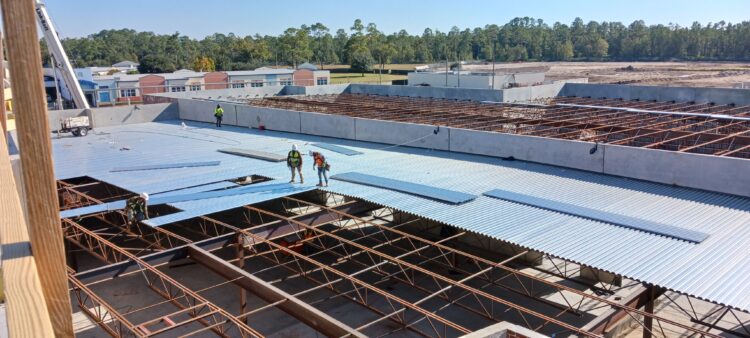Dec. 4, 2023 — Significant changes in the economic, financial, and legislative landscape have resulted in a funding gap for the district’s Master Facility Plan (MFP), the renovation and rebuilding program funded by revenue from the voter-approved, half-penny sales tax.
In an update presented at a recent school board workshop, district staff advised board members that it will not be feasible to continue the plan without making significant adjustments.
“When Duval County voters approved the voluntary half-penny sales tax in November 2020, we promised financial transparency. Nearly three years later, I believe the district has kept that promise,” said Superintendent Dr. Dana Kriznar. “From setting up a special website, creating a project dashboard, and establishing an independent Oversight Committee, we’ve worked hard to keep the public apprised of our progress in replacing, renovating, and repairing our aging campuses.”
The presentation at the board workshop was another effort to be fully transparent about the economic factors impacting the plan’s costs and revenue.
The original plan, which was approved by school board members in July 2019, carried a price tag of $1.91 billion. However, staff now project the plan will cost $3.91 billion to complete due to COVID-related inflation and supply-chain issues. Additionally, new laws requiring revenue sharing with charter schools have widened the gap between expected revenues and expected costs of the original plan.
The Original Master Facility Plan
Prior to the half-penny sales tax passing in 2020, district staff created the MFP, known as “A Bold Plan for DCPS.” The 15-year plan was designed to address more than $1 billion in deferred maintenance, improve the safety and security of each school, remove most portables, right-size the district to cut administrative costs, and improve learning environments for our students.
The expected sources of revenue for the MFP would come from a 75%-25% split between revenue from the proposed half-penny sales tax and the capital outlay revenue the district regularly receives from millage rates. Once the referendum was approved by voters in 2020, district leaders moved forward in fulfilling the plan with those funding sources.
“I’m proud to say our district dove in headfirst putting this MFP into action. In just under three years, all our schools have better safety and security,” said Dr. Kriznar. “We opened our first new school in 12 years, with eight more new campuses on the horizon.”
Factors Impacting The MFP
As district staff continued to execute the MFP, they encountered significant challenges that can be broken down into two major categories:
- COVID-related inflation and supply-chain issues: Duval County Public Schools has not been immune to the skyrocketing costs of materials, labor, and supply-chain disruptions spurred by the COVID-19 pandemic. While some prices have begun to stabilize, they remain high in the construction sector.
“We could not have predicted the impact a global pandemic would have on our plan when it was drafted in 2019,” said Dr. Kriznar.
For example, when district staff initially budgeted the cost to build a new Rutledge H. Pearson Elementary School in 2019, the estimated price tag was $28.75 million. But when the school was completed in August 2023, that cost increased to $40.44 million – a 40.7% increase. Some examples of other campuses with projected increases include Chaffee Trail Middle at an estimated 57% budget increase, Highlands Elementary School at an 84.9% increase, and Southside Estates Elementary School at a 94% increase.
- New laws shifting funds to charter schools: Recent changes in Florida law have resulted in a reduction of the sales-tax revenue and capital outlay funds going toward the MFP. During the 2020 legislative session, after the MFP was already approved by the school board, state lawmakers passed a law requiring that school districts share revenue from the half-penny sales tax with charter schools on a per-student basis. As of June 2023, more than $45 million of the district’s sales-tax revenue (just over 15%) has been reallocated to charter schools.
State lawmakers additionally passed a law in 2023 requiring the district to begin sharing its normal capital outlay revenue with charter schools, also on a per-student basis, beginning with the 2023-24 school year. Charter schools also receive capital funding from another source called PECO (Public Education Capital Outlay) that traditional schools do not receive. It is estimated that the combination of sharing the sales surtax revenue and capital outlay with charter schools over the life of the MFP (from 2020 through 2036) will be $860 million.
A New Bottom Line
When combining the financial impact of increased costs with these recent statutory requirements, the bottom line has changed dramatically, with the district no longer having enough revenue to carry out the MFP as originally planned. As previously stated, the original 15-year plan cost $1.91 billion, but it is now projected that the MFP will cost $3.91 billion to complete in its entirety. Although projected revenue has also increased, staff project the revenue available to traditional schools will be $2.51 billion, leaving the district with a $1.4 billion gap.
“We are absolutely not considering another tax increase. But we also don’t want to go back on our promise to improve learning environments for our students and teachers,” said Dr. Kriznar.
Alternatives In Discussion
District staff has brought the following alternatives to the school board:
- Issue additional bonds: Staff propose generating more for the MFP by issuing up to four additional bonds to cover the funding gap. The bonds would be paid back over time by using the normal capital outlay funding available to the district through the millage.
“To be clear, we are not proposing increased millage rates to pay back these bonds,” shared Dr. Kriznar. “Our strategy would be to reallocate our existing funds to pay back these bonds as quickly and responsibly as possible. “
- Right size schools through consolidations to reduce costs: Recent trends have shown a nationwide decline in public school enrollment. Duval County Public Schools is currently operating at 76% capacity, a decline leaders project will continue over the next decade.
To counter this trend, leaders propose increasing efficiency through closing and consolidating campuses, which reduces the need to complete deferred maintenance and major renovations. District staff say by rightsizing the district, operations are optimized, with cost savings in the potential millions.
What’s Next For The MFP
Upon receiving this information in a recent workshop, board members expressed plans to pursue more in-depth review, guidance, and conversation in pursuit of the best path moving forward. Other alternatives may emerge through their discussions.
Those seeking to remain informed about the process can visit the half-penny website.









11 Comments
Comments are closed.